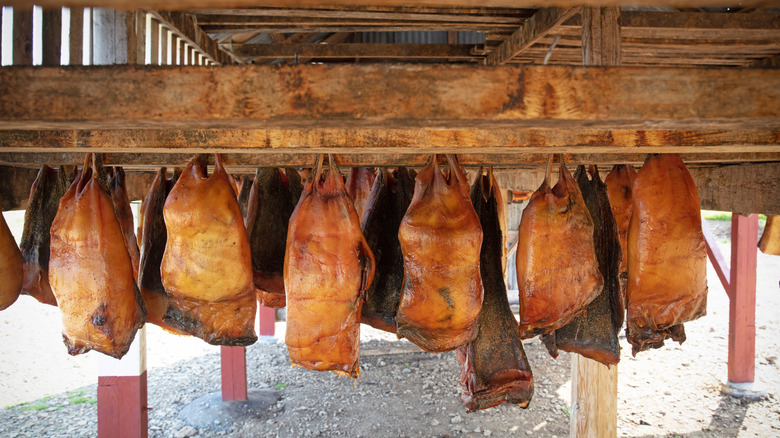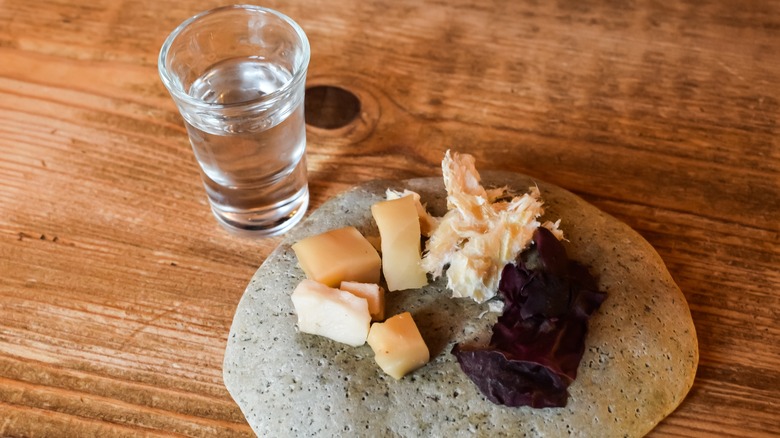The Food Anthony Bourdain Said Was The Worst He Ever Ate
Some would say it was his cooking skills that gave Anthony Bourdain a legendary reputation. Others might insist that it was his cutting wit, brutal honesty, and controversial exposés that did the trick. Yet, others would agree that it was Bourdain's cast-iron stomach and appetite for diving head-first into the delicacies of any place he traveled to that made him a culinary character unlike any other. From cobra hearts and goose intestines to fertilized duck eggs, pig's brains, and fried rice with maggots, Bourdain's palate was as adventurous as his travels across the world.
Every so often though, the "Parts Unknown" host met a dish that he didn't quite fancy. Fast food and airport meals were often where he drew the line, and believe it or not, pumpkin spice was among the many foods that Bourdain hated with a passion. But it was hákarl — fermented Greenland shark from Iceland — that Bourdain admitted was tops on his list of the worst things he'd ever eaten, right alongside Namibian warthog rectum.
Bourdain tried hákarl on a trip to Iceland during episode two in the first season of "No Reservation." While joining locals at Reykjavik's Mulakaffi restaurant, Bourdain bit into a cube of six-month-long fermented shark, calling it "the single worst thing that I've ever put in my mouth" (via Dailymotion). Yet, although Bourdain may not have had a stomach for fermented shark, hákarl is a much-loved delicacy in Iceland, and one that is steeped in history, tradition, and the country's geographical location.
Hákarl is a beloved Icelandic delicacy
Anthony Bourdain's Icelandic visit coincided with the country's annual thorrablot celebrations, which happen at the start of each year. This midwinter pagan festival is celebrated with a feast of traditional Icelandic foods, including delicacies enjoyed by the Vikings. Fermented, dried, salted, smoked, and pickled cured meats are essential at these banquets and things like fermented shark, boiled sheep's head, and ram's testicles are particular favorites — all of which Bourdain had the chance to taste during the filming of the episode.
There are several theories as to how hákarl came to be the delicacy it is, with most agreeing that it was the country's location that had ancient settlers looking towards the ocean's bounty to fill their bellies. Some believe that, although Greenland sharks have always lived in the waters surrounding Iceland, they were used for little besides their liver oil to power lamps. In fact, the poisonous nature of Greenland sharks kept them from being a food source — that is until the remains of one were found on Iceland's shores in the 17th century.
Soon, Icelanders found shark meat to be an important source of nourishment in a water-locked country where fresh produce was hard to come by. Furthermore, they found a way to ferment the washed-up shark to remove its toxins and make it safe for consumption. Others, however, suggest that hákarl has been around for much longer, since the time of the Vikings, though they too were driven by the same need to find a food source in the harsh climate of Iceland.
How is hákarl made and what does it taste like?
Over the years, hákarl has gained a rather unsavory reputation. Chefs like Gordon Ramsay have spat out the fermented shark meat on TV shows, and Andrew Zimmern has called its odor among the worst things he's ever smelt. It's an odor that Greenland sharks have due to an abundance of uric acid from their lack of kidneys. Even so, hákarl is a beloved delicacy in Iceland — it's a funky, fermented food that happens to be a national favorite.
Today, hákarl continues to be made from Greenland sharks that are fermented to get rid of their poisonous toxins. Though some have transitioned to simple containers to ferment the sharks, traditional methods preferred by the Vikings involve burying the animals in holes dug in the sand, and pressing them with large rocks to get rid of their bodily fluids — a process that can take up to six months. The shark is then sliced into strips, hung to air dry for a couple more months, and then cut into cubes after its leathery texture turns into a chewy, cheesy feel.
Once fermented, hákarl's flavor is described as having the funky tone of blue cheese with sweet and nutty notes. But it's nothing that a quick shot of Brennivín can't take off — the Icelandic spirit is spiced with dill, caraway, and cumin that's often drunk with hakarl.



